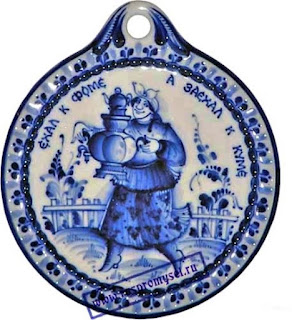Gzhel is a national Russian folk craft consisting of blue and white painting on ceramics. The region with the same name, which includes 27 villages and which is one of the Russian centers for the production of ceramics, is located 60 km from Moscow.
Gzhel has long been famous for its high-quality clay deposits. The first mention of Gzhel goes back to the 14th century.
An interesting fact about this area is that there has never been serfdom there. Gzhel belonged to the imperial court, and the craft was the main occupation of the local population. This made it possible to concentrate all forces on honing the skills and improving production technologies.
By 1812 there were 25 factories producing ceramic dishes in Gzhel. In addition to dishes, they used to make toys in the form of birds and animals, as well as decorative statues based on motives from Russian life. Shiny white figures were painted with lilac, yellow, blue and brown colors in a peculiar folk style. Flowers, leaves, herbs served as motives for the decorations.
The flourishing of the Gzhel art industry came in the second half of the 18th and the first half of the 19th centuries. At the beginning of the 19th century, porcelain started being produced there. At first, painting on porcelain was colored, but in the middle of the 19th century the fashion for blue and white Dutch tiles and Chinese porcelain came to Russia. Russian craftsmen adopted the trend and very soon blue patterns on a snowy background became a hallmark of Gzhel painting.
The industrial revolution with its transition from manual labor to machine industry caused a general economic upturn in the second half of the 19th century, but at the same time virtually destroyed the Gzhel national art craft with its hand-made molding and painting. Enterprises massively switched to the production of technical porcelain for the pharmaceutical and electrical industries. Many secrets and subtleties of the artistic craft were sadly forgotten and lost.
Then there were three wars of the first half of the twentieth century with their devastation, lack of fuel and raw materials. All this, as it seemed, finally buried the artistic traditions of the Gzhel craft. But fortunately, Gzhel was reborn in the middle of the twentieth century.
The blue-and-white painting successfully fit into the cultural code of the Russian mentality – a combination of blue sky, white churches and golden domes. But the main style-forming element is a “smear with shadows” that creates a multitude of subtle gradations of blue.
Nowadays, artists and masters of the Gzhel Association are the true bearers of the Gzhel traditions. Many of them are representatives of the Gzhel dynasties. They secured and, at the same time, brought a lot of new in the artistic image of the craft. Today, their products are classics and samples of real craftsmanship.







Комментариев нет:
Отправить комментарий